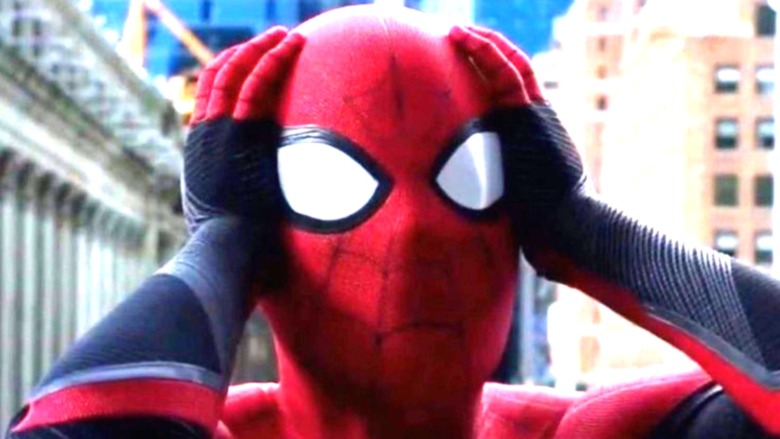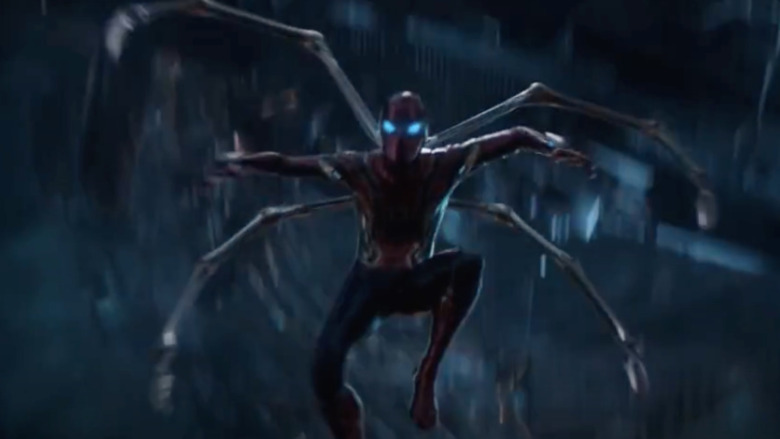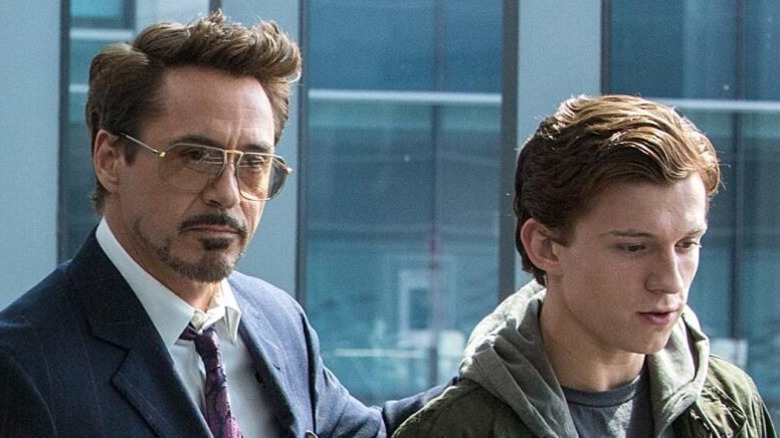Why Spider-Man's MCU Costumes Make No Sense
Spider-Man's modern film legacy began with Tobey Maguire's 2002 film, which launched a new era of superheroes in cinema. Maguire's Spider-Man had perhaps the simplest costume, sewn by Peter Parker from stretchable fabric, which regularly ripped and tore during battle. It also lacked accessories, since Peter's webbing was organic. The second Spider-Man iteration starring Andrew Garfield also showcased a homemade spandex suit, but added mechanical wrist attachments to shoot webbing. With no other gadgets, this outfit also took on its share of visible wear and tear — similar to the first design.
Then, after Sony Studios came to an agreement with Disney and Marvel Studios, Tom Holland took up the mantle, bringing the eight-legged web-slinger into the MCU. The problem is that, unlike previous adaptations, this Spider-Man is gifted with high-tech Spider-suits, replete with all sorts of contraptions. Although the attire is very helpful in battle, these suits are unfaithful to the core of the Spider-Man character and what he represents.
The Iron Spider-suit Peter wears in Avengers: Infinity War
From his very first appearance in the MCU, Peter received a series of Spider-suits courtesy of Iron Man (Robert Downey Jr.) As Screen Rant highlights, these gadget-centric garments include abilities like combat mode, interrogation mode, drones, parachutes, heating systems, web grenades, stun webs, nets, pulleys, ricochet webs, and an A.I. named Karen. Although Peter does try to keep his classic costume, the events of "Avengers: Infinity War" force him to accept the Iron Spider-suit – his most enhanced to date, complete with bulletproof nanotech, four spider-legs on the back, and an instant kill mode.
As cool as they may seem, these outfits completely fail to represent Spider-Man's authentic characterization, and underscore his superpowers as being wardrobe-dependent, like some kind of arachnid Iron Man. The fact that his original suits were minimally adorned and handmade illustrated the genuine challenges facing the cash-strapped teenager, and exemplified that his skill came from his abilities and not his outfit.
Stan Lee said in a 2006 NPR interview, "I thought it'd be even more interesting to make him (Spider-Man) a kid with the normal problems ... when he'd have a fight with a villain, his costume would get torn and he didn't know how to sew. You couldn't go to a tailor and say, 'would you fix my Spider-Man costume?'"
Spider-Man isn't supposed to be a billionaire like Batman or Iron Man with unlimited funds to make himself a superhero. He's just a regular kid who finds himself in the position of being a superhero thanks to a radioactive spider bite. In the same way that Superman is still Superman when not wearing his cape and trademark emblem, Spider-Man is still Spider-Man without the red boots and webbed mask. It's not the costume that makes him a superhero — it's him.
Tony Stark serves as a father figure to Spidey
The other problem with this setup is that Stark is the one doing all the inventing. Peter is supposed to be a genius in his own right. He should be capable of making things for himself — like the web-shooters. His intellect and brilliance have been an integral part of the comics and previous movies. However, Stark's legacy, supplies, and capital are no match for a teenager without the same privileges and opportunities.
Instead of crafting a costume through his own ingenuity, Peter relies on the creativity (and spending power) of others. Consequently, by minimizing his personal contribution, the MCU films dilute his unique superhero identity. The Spider-suits Tony provides are clearly based on the Iron Man design. They're more metal than fabric, and studded with gadgets. Had Peter been the one to create his own suit, not only would it be a more authentic reflection of his personality and experience, but it would allow him to step out of the shadow of Stark, and take hold of his independence.
Emotionally, with Stark essentially filling the father figure role meant for Uncle Ben, the Marvel Universe has subverted the motivations of the character and made him less relatable than he was originally meant to be. He's no longer the spider-bitten teenager dealing with the same problems as the rest of us. Now, he's just a kid with a wealthy uncle who bought him an expensive suit.


